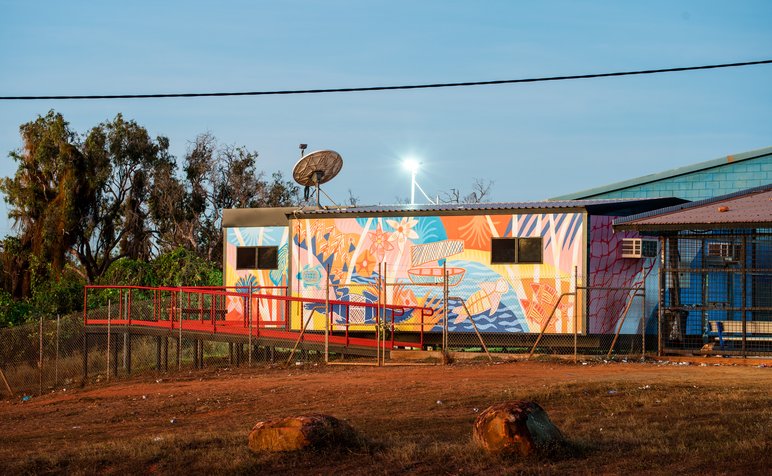
Nanja literally translates to nets in Nunggubuyu language. However these days nanja mainly refers to introduced marine debris – discarded fishing nets, shade cloth, nautical rope and other cast-off materials that plague ocean and river sources. Numburindi people first noticed nanja washing up on the beaches of Numbulwar in the 1980s. Today, these synthetic invaders are a daily reality, building up in the Gulf of Carpentaria, threatening marine life and disrupting traditional ways of living. Yet from this adversity, a unique form of expression has emerged.
Numburindi people have used dilly bags for thousands of years for practical and ceremonial purposes, but not until recently were they produced from repurposed ghost nets and shade cloth fabric. Dilly bags, or “yir” in Nunggubuyu language, are customarily made from pandanus or bark fibres, and dyed or painted with shades of ochre.
“These dilly bags, they used to carry bush tucker, and sometimes they carried wild honey, in the olden days.”
The four Wilfred sisters whose work is exhibited here – Joy, Jocelyn, Megan and Virginia – are known as the Wagilak sisters. In a Dhuwa story told in Ritharrngu language in central Arnhem Land, the Wagilak Sisters are Creation Sisters. The sisters each have their own dilly bags that contain all their power, holding sacred ornaments and power objects that they use to create the landscape. Through their stewardship, the landscape becomes lush and beautiful. The sisters are the keepers and teachers of the law.
The Wilfred sisters replicate traditional dilly bags with found contemporary materials like nanja to tell a contemporary narrative about the environmental deterioration of their homelands, but also the responsibility that befalls custodians in making Country beautiful again. Brightly coloured acrylics replace ochre stripes for clan identification and individual expression.

Collect online
View the exhibition online and explore available works by Joy, Jocelyn, Megan and Virginia Wilfred.
With ghost nets accounting for approximately 40% of all ocean plastic, this shift towards synthetic materials not only reflects the changing environmental landscape but also symbolises resilience, adaptation, and an unwavering connection to Country. The act of creating nanja dilly bags is one of caring for Country: Numburindi rangers salvage and transport the marine debris to the art centre, where it is meticulously stripped, cleaned, and reworked into yir (dilly bags) by the artists.
“Every time when them ladies do ghost net bag, nanja, they think about in the olden days how they were making the string bag. Like old way and new way, together. We like working old way and new way.”
“It’s important for young people to carry this on, for them to have the knowledge, for us to keep passing it on to them, always.”
*All quotes are attributed to Rose Wilfred, niece of exhibiting artists and an esteemed artist and arts worker herself.
